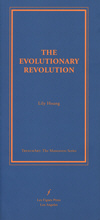The Evolutionary Revolution
The latest release from Lily Hoang, The Evolutionary Revolution is a history unto itself. Both a fable and a myth (“Myth is about the past, fable is about the future.”), this title revolves around stories of an ancient, watery Earth populated by “subspecies,” one of which is man, although she does not physically resemble modern homo sapiens. (I know I’ve used “man” and “she” together. It’s an oft-employed technique from the book, one of many contradictions of language that whirl about and simply shrug off their own existences, adding to the intricate mystery and progression of Hoang’s work.)
The latest release from Lily Hoang, The Evolutionary Revolution is a history unto itself. Both a fable and a myth (“Myth is about the past, fable is about the future.”), this title revolves around stories of an ancient, watery Earth populated by “subspecies,” one of which is man, although she does not physically resemble modern homo sapiens. (I know I’ve used “man” and “she” together. It’s an oft-employed technique from the book, one of many contradictions of language that whirl about and simply shrug off their own existences, adding to the intricate mystery and progression of Hoang’s work.)
This old Earth shares a deep bond with contemporary society in the form of a mysterious and power-endowed family, the Sylphs, including a two-headed boy, Eliot and Sylvester, a thigh-winged girl, Chloe, and other curious beings. This is one of The Evolutionary Revolution’s greatest strengths: the rich yet subtle characterizations and interactions twist in ways exotic and unexpected. I simply could not put the book down, beginning to form a very strong bond with these characters and the fate of their world(s).
It’s difficult to explain too much about the Sylphs, the Imperial Council, mermen, or the beast with three thousand sets of eyes without spoiling some of Hoang’s experimental techniques. Here we can see a short example of her myth-unfolding style, the casual yet profound tone she gives to this history:
Just one day of physical separation, and the Sylph boys are losing their collective memory. Their singular memories – that’s fine – but anything they experienced together is beginning to erase. Their earliest memory is the day they chose to be conjoined. Their father, a man they barely remembered even when they were double boys, appeared in their small, unformed ideas and persuaded them to hold each other tight. They were, at this point, not even fetuses. They had no body, and even as ideas, they were scattered, barely coherent, but they remember their father’s words and when they were given bodies, they held each other with such force, with such passion, that their bodies melted together.
There’s an uncanny depth to Hoang’s style, choppy and full like salty ocean waves (an image of relevance to the novel). At times, Hoang’s individual sentences seem daringly simple, but this effect only furthers her fable/myth motifs. The wider tapestry is voluptuous and exquisite, each small chapter ending on a note of poetic toast. The novel can feel more like a series of prose poems tied by a number of recurring narratives (which is appropriate, given Hoang’s status as a recipient of Chiasmus Press’s Un-Doing the Novel Contest). But like any good work of multiple narratives, the intermingled plotlines take a turn towards each other and the namesake event, a collision of ancient past, tumultuous present, and predestined future. The Evolutionary Revolution is a thoughtful and endearing work that will leave you dreaming in Hoang’s imaginative past for days.





